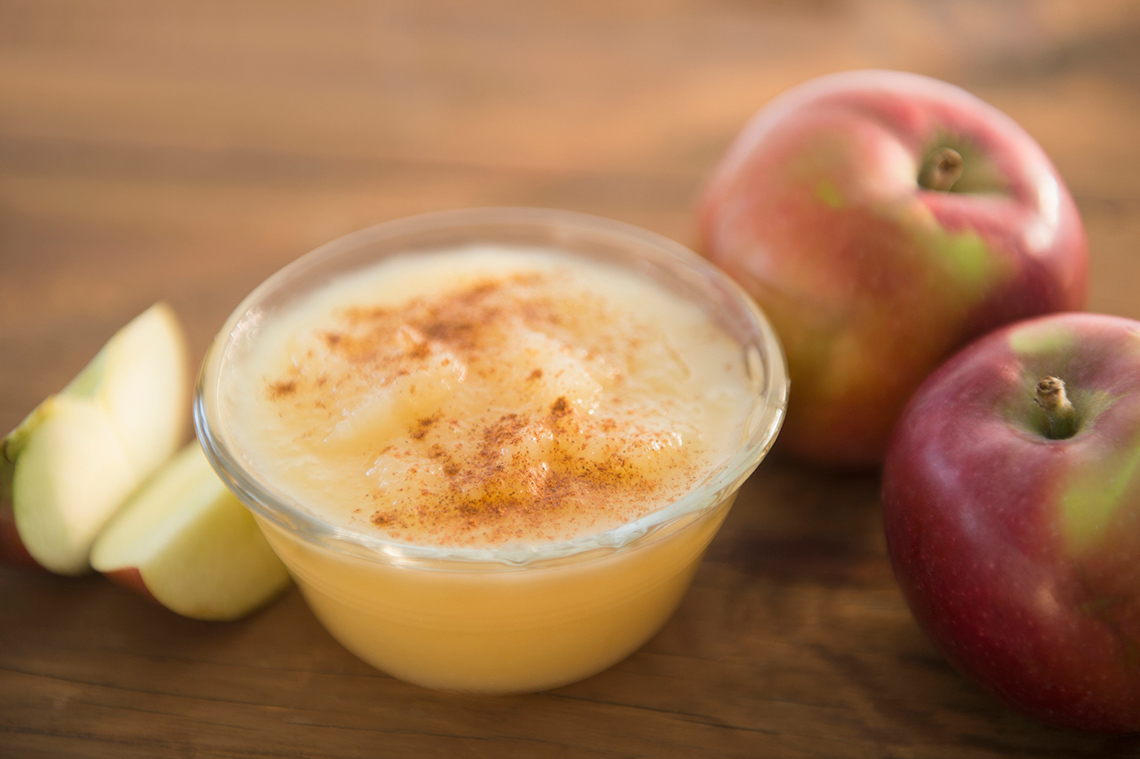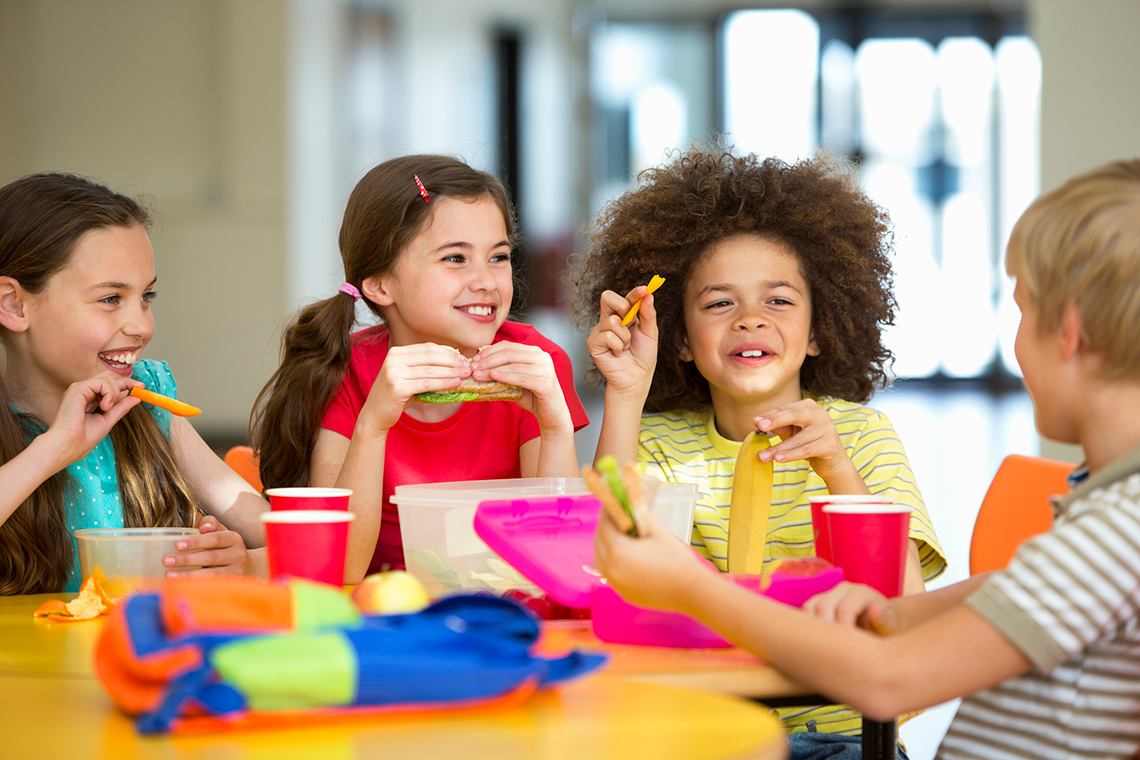Minds On
Where does food come from?
Many of the foods we eat come from the grocery store, but where did they come from before that?
Let’s explore the following images and think about where they come from.

Apples
Where do apples come from?
Press ‘Let’s Check!’ to explore a possible answer.
Apples grow on a tree in an orchard. They are harvested in the fall.

Apple juice
Where does apple juice come from?
Press ‘Let’s Check!’ to explore a possible answer.
Once the apples are harvested, they are then pressed into juice in a facility. Some of the nutrients in the apple are lost during this process.

Applesauce
Where does applesauce come from?
How is it changed or processed?
Press ‘Let’s Check!’ to explore a possible answer.
Applesauce is a sauce made of apples. It can be made with peeled or unpeeled apples and may be spiced or sweetened.
Applesauce is processed in a facility and packaged in bottles or cans. When food is processed, it loses some of its nutritional value.
Action
Which one?
For each question, choose the food item that is the most processed.
Select the correct answer, then press ‘Check Answer’ to see how you did.
Making healthy choices
Check out this video entitled “Sugar in Our Lunches” to learn more about sugar in the foods we eat.
After exploring the video, let’s reflect on how food is processed and what we did not know before.
What three pieces of information would you like to share with someone?
Record your thoughts in a notebook or another method of your choice.
Food map
Let’s create a food map!
Explore the following steps to help guide you:
1. Choose a food item.
For example, apples, cheese, bread, milk, or etc.
You may choose any of the following food items, or another food of your choice.
Press the following tabs to explore different foods.
Cheese is made from stirring milk that has been pasteurized. This means that the milk is heated, and the bacteria has been taken out.
Then it is thickened through adding a gel like substance and constant stirring to harden it into chunks. The water is drained from the chunks until it is hardened and pressed into a mold. Then salt is added and it dries in the air.
Ice cream is made by blending together milk, cream, sugar, and vanilla. If any other ingredients are added, they are poured in once the mixture is blended, then the mixture is blended again.
The mixture is then poured into a freezer safe container and placed into the freezer with the lid on top until it is frozen.
2. How is it grown? How is it produced or made?
3. What other foods can your food be made into or added to?
Complete the Food Map activity in your notebook or using the following fillable and printable document. If you would like, you can use speech-to-text or audio recording tools to record your thoughts.
Press ‘Let’s Check!’ to explore a food map example.

A food map example with an apple as the chosen food. The apple comes from apple trees that are grown on the farm. The apple can be made into or added to apple juice, applesauce, apple pie, and much more!
apple food map
Environment and food
The way our food is produced, processed, and delivered can affect the environment.
Many foods are highly processed and have to be shipped either by air or by water. This delivery method increases air and water pollution, which affects the environment.
Also, the packaging for these foods creates an extra waste and is hard to recycle.
The way we eat and throw food out leads to food loss and wasting food.
For example, taking more than what we can eat or throwing out leftovers.
When we eat foods that are grown in our community or nearby communities, we are eating local foods.
Eating local foods are better for the environment because they do not have to travel long distances to get to our plates. They are also nutritious and taste better.
So, how can we help the environment?

Helping the environment

To help keep the environment safe and healthy, we can use more unprocessed or minimally processed foods.
Instead of plastic, we can use reusable water bottles and food containers.
When we make meals at home, we can make sure to use the unprocessed foods first and remember to eat our leftovers.
Nutrients

We need certain nutrients, which is like fuel for our body, to help us grow.
Nutrients give energy. They make bones and muscles strong and help fight sicknesses.
There are six major nutrients:
- carbohydrates
- fats
- proteins
- vitamins
- minerals
- water
Press the following tabs to explore more details about nutrients.
Carbohydrates or carbs are a major source of energy for the body. The body breaks down carbs into sugars and starches, which are great for the body.

Carbohydrates can be split into two groups, sugars and starches. In the sugars group, there's fruit, vegetables, beans, milk, and dairy products. The starches group is rice, potatoes, breads, cereals, and grains.
Most of the foods we eat have carbohydrates. It is really important to include carbs in our meals to stay alert and active!
Fats keep the body warm, protect our organs, and carry vitamins all over the body.
There are healthy fats and unhealthy fats too!
Healthy fats are great for the body. They are found in foods like nuts, avocados, fish, eggs, and soybeans.

Too many unhealthy fats can result in health problems, which are found mostly in processed foods, like packaged cookies, candy, and chips.
Proteins are important for growth and repair of our bodies, like our bones and muscles.
Foods that are rich in protein are lean meat, eggs, fish, tofu, seeds, nuts, and beans.

Vitamins help the body to work properly, so that we can grow and stay healthy. Different foods have various vitamins. There are all sorts of vitamins, and each vitamin plays a special role.
For example:
- Broccoli and other green vegetables have vitamin K, which helps the body to heal if there is a small cut, like a paper cut.
- There’s vitamin D in milk to help our bones.
- Vitamin C helps keep our gums and bones in good shape. Vitamin C can be found in oranges!

Did you think minerals could only be found in the earth?
There are small amounts of minerals in food too!
Minerals help the body grow and stay healthy, like building strong bones.
For example, calcium is mineral that helps with our bones. It helps the body to build healthy, strong teeth for chewing our tasty food.
Calcium can be found in green vegetables and dairy products, like milk, cheese, yogurt, and much more!

Water helps the body function and keeps the body healthy. Drinking lots of water while being active is important. Water also helps to keep the body temperature normal.

Did You Know?
Did you know?
Fresh food has lots of the important nutrients you need. Sometimes, fresh foods are called “whole foods.”
Processed foods
When food is processed, it means that the food has been altered or changed, and that there are less nutrients.
Food can be processed by being:
- cooked
- frozen
- dried
- canned
- mixed with other ingredients to make it last longer
Almost all of the food we eat is processed in some way. Apples, berries, lettuces and corn on the cob are just some examples of foods in Ontario that can be eaten without being processed.
There are also different types of processed food.
Press the following tabs to explore various types of processed foods.
Unprocessed foods are raw or in their original form.
When picked from the tree, an apple is an example of an unprocessed food.

Processed foods have been changed in some way to help preserve them or make them easier to use and sell.
Minimally processed foods, like bagged apple slices or frozen vegetables, haven’t been changed much.
Freezing foods can help foods keep their nutrients.

Highly processed foods have changed a lot from their original form.
The more food is processed, the more nutrients it may lose.
For example, instant mashed potatoes, sweetened breakfast cereals, potato chips, and juice boxes are all highly processed foods.

Consolidation
Learning check!
Reflect on each statement, which are great ways we can help the environment.
For each sentence, select the missing word from the drop-down menu.
Let's Review
How is eating local foods better for our bodies and better for the environment?
Record your thinking in a method of your choice.
Reflection
How do you feel about what you have learned in this activity? Which of the next four sentences best matches how you are feeling about your learning? Press the button that is beside this sentence.
I feel…
Now, record your ideas about your feelings using a voice recorder, speech-to-text, or writing tool.
